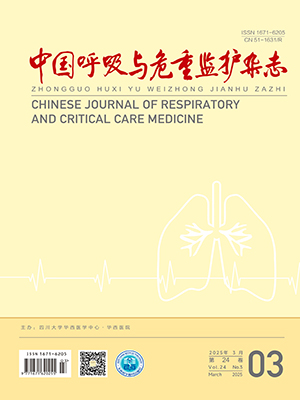| 1. |
Zhu N, Zhang D, Wang W, et al. A novel coronavirus from patients with pneumonia in China, 2019. N Engl J Med, 2020, 382(8): 727-733.
|
| 2. |
Guan WJ, Ni ZY, Hu Y, et al. Clinical Characteristics of Coronavirus Disease 2019 in China. N Engl J Med, 2020, 382(18): 1708-1720.
|
| 3. |
Zha L, Shen Y, Pan L, et al. Follow-up study on pulmonary function and radiological changes in critically ill patients with COVID-19. J Infect, 2021, 82(1): 159-198.
|
| 4. |
国家卫生健康委办公厅, 国家中医药管理局办公室. 《新型冠状病毒肺炎诊疗方案(试行第七版)》[EB/OL]. http://www.gov.cn/zhengce/zhengceku/2020-03/04/5486705/files/ae61004f930d47598711a0d4cbf874a9.pdf.
|
| 5. |
中国医师协会呼吸医师分会肺功能与临床呼吸生理工作委员会, 中华医学会呼吸病学分会呼吸治疗学组肺功能专业组. 新型冠状病毒肺炎疫情防控期间开展肺功能检查的专家共识. 中华结核和呼吸杂志, 2020, 43(4): 302-307.
|
| 6. |
中华医学会呼吸病学分会肺功能专业组. 肺功能检查指南(第二部分)—肺量计检查. 中华结核和呼吸杂志, 2014, 37(7): 481-486.
|
| 7. |
中华医学会呼吸病学分会肺功能专业组. 肺功能检查指南—肺弥散功能检查. 中华结核和呼吸杂志, 2015, 38(3): 164-169.
|
| 8. |
Torres-Castro R, Solis-Navarro L, Sitjà-Rabert M, et al. Functional limitations post-COVID-19: a comprehensive assessment strategy. Arch Bronconeumol, 2021, 57 Suppl 1: 7-8.
|
| 9. |
Liu K, Zhang W, Yang Y, et al. Respiratory rehabilitation in elderly patients with COVID-19: a randomized controlled study. Complement Ther Clin Pract, 2020, 39: 101166.
|
| 10. |
Nusair S. Abnormal carbon monoxide diffusion capacity in COVID-19 patients at time of hospital discharge. Eur Respir J, 2020, 56(1): 2001832.
|
| 11. |
Chapman DG, Badal T, King GG, et al. Caution in interpretation of abnormal carbon monoxide diffusion capacity in COVID-19 patients. Eur Respir J, 2021, 57(1): 2003263.
|
| 12. |
Chen R, Gao Y, Chen M, et al. Impaired pulmonary function in discharged patients with COVID-19: more work ahead. Eur Respir J, 2020, 56(1): 2002194.
|
| 13. |
Frija-Masson J, Debray MP, Gilbert M, et al. Functional characteristics of patients with SARS-CoV-2 pneumonia at 30 days post-infection. Eur Respir J, 2020, 56(2): 2001754.
|
| 14. |
Huang Y, Tan C, Wu J, et al. Impact of coronavirus disease 2019 on pulmonary function in early convalescence phase. Respir Res, 2020, 21(1): 163.
|
| 15. |
American Thoracic Society, American College of Chest Physicians. ATS/ACCP statement on cardiopulmonary exercise testing. Am J Respir Crit Care Med, 2003, 167(2): 211-277.
|
| 16. |
Miyazaki A, Adachi H, Oshima S, et al. Blood flow redistribution during exercise contributes to exercise tolerance in patients with chronic heart failure. Circ J, 2007, 71(4): 465-470.
|
| 17. |
De Giorgio MR, Di Noia S, Morciano C, et al. The impact of SARS-CoV-2 on skeletal muscles. Acta Myol, 2020, 39(4): 307-312.
|
| 18. |
Meo SA, Alhowikan AM, Al-Khlaiwi T, et al. Novel coronavirus 2019-nCoV: prevalence, biological and clinical characteristics comparison with SARS-CoV and MERS-CoV. Eur Rev Med Pharmacol Sci, 2020, 24(4): 2012-2019.
|
| 19. |
Ong KC, Ng AW, Lee LS, et al. Pulmonary function and exercise capacity in survivors of severe acute respiratory syndrome. Eur Respir J, 2004, 24(3): 436-442.
|





 Baidu Scholar
Baidu Scholar